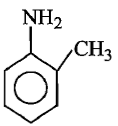Reaction of cyclohexanone with dimethylamine in the presence of catalytic amount of an acid forms a compound if water during the reaction is continuously removed. The compound formed is generally known as:
(1) Schiff's base
(2) an enamine
(3) an imine
(4) an amine
एक अम्ल की उत्प्रेरक मात्रा की उपस्थिति में डाइमेथिलऐमीन के साथ साइक्लोहेक्सेनोन की अभिक्रिया एक यौगिक बनाती है यदि अभिक्रिया के दौरान जल के अणु सतत निष्कासित किए जाते है। निर्मित यौगिक को सामान्यतः निम्नलिखित के रूप में जाना जाता है:
1. शिफ क्षार
2. एक एनामीन
3. एक इमीन
4. एक ऐमीन
The alkene formed as a major product in the given elimination reaction is:
1. 
2.
3. 
4. 
दी गई विलोपन अभिक्रिया में एक प्रमुख उत्पाद के रूप में निर्मित एल्कीन है:
1. 
2.
3. 
4. 
Product (A) & (B) of the above reaction is:-
1. A=P,B=P
2. A=Q,B=Q
3. A=P,B=Q
4. A=Q,B=P
*ऊष्मा
*ऊष्मा
उपरोक्त अभीक्रिया का उत्पाद (A) और (B) है:
1. A=P,B=P
2. A=Q,B=Q
3. A=P,B=Q
4. A=Q,B=P
Which of the following is the strongest base ?
1. 
2. 
3. 
4. 
निम्नलिखित में से कौन सा प्रबल क्षारीय है?
1. 
2. 
3. 
4. 
Which one of the following compound give carboxylic acid by hydrolysis ?
(1)
(2)
(3)
(4) All of these
निम्नलिखित में से कौन सा यौगिक जल-अपघटन द्वारा कार्बोक्सिलिक अम्ल देता है?
(1)
(2)
(3)
(4) ये सब

1. 
2. 
3. 
4. 

1. 
2. 
3. 
4. 
Which of the following will be most stable diazonium salt ?
1.
2.
3.
4.
निम्नलिखित में से कौन सा अधिक स्थायी डाइएजोनियम लवण होगा?
1.
2.
3.
4.
C (major product) is
| (1) |  |
| (2) |  |
| (3) | |
| (4) | none of these |
C (प्रमुख उत्पाद) है:
| (1) |  |
| (2) |  |
| (3) | |
| (4) | इनमें से कोई नहीं |
Intermediates formed during the reaction of RCONH2 with Br2 and KOH are
1. RCONHBr and RNCO
2. RNHCOBr and RNCO
3. RNHBr and RCONHBr
4. RCONBr2
RCONH2 की Br2 और KOH के साथ अभिक्रिया के दौरान निर्मित मध्यवर्ती हैं:
1. RCONHBr और RNCO
2. RNHCOBr और RNCO
3. RNHBr और RCONHBr
4. RCONBr2















